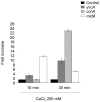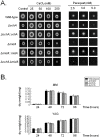The involvement of the Mid1/Cch1/Yvc1 calcium channels in Aspergillus fumigatus virulence
- PMID: 25083783
- PMCID: PMC4118995
- DOI: 10.1371/journal.pone.0103957
The involvement of the Mid1/Cch1/Yvc1 calcium channels in Aspergillus fumigatus virulence
Abstract
Aspergillus fumigatus is a major opportunistic pathogen and allergen of mammals. Calcium homeostasis and signaling is essential for numerous biological processes and also influences A. fumigatus pathogenicity. The presented study characterized the function of the A. fumigatus homologues of three Saccharomyces cerevisiae calcium channels, voltage-gated Cch1, stretch-activated Mid1 and vacuolar Yvc1. The A. fumigatus calcium channels cchA, midA and yvcA were regulated at transcriptional level by increased calcium levels. The YvcA::GFP fusion protein localized to the vacuoles. Both ΔcchA and ΔmidA mutant strains showed reduced radial growth rate in nutrient-poor minimal media. Interestingly, this growth defect in the ΔcchA strain was rescued by the exogenous addition of CaCl2. The ΔcchA, ΔmidA, and ΔcchA ΔmidA strains were also sensitive to the oxidative stress inducer, paraquat. Restriction of external Ca(2+) through the addition of the Ca(2+)-chelator EGTA impacted upon the growth of the ΔcchA and ΔmidA strains. All the A. fumigatus ΔcchA, ΔmidA, and ΔyvcA strains demonstrated attenuated virulence in a neutropenic murine model of invasive pulmonary aspergillosis. Infection with the parental strain resulted in a 100% mortality rate at 15 days post-infection, while the mortality rate of the ΔcchA, ΔmidA, and ΔyvcA strains after 15 days post-infection was only 25%. Collectively, this investigation strongly indicates that CchA, MidA, and YvcA play a role in A. fumigatus calcium homeostasis and virulence.
Conflict of interest statement
Figures











References
-
- Berridge MJ, Bootman MD, Llewelyn Roderick H (2003) Calcium Signalling: Dynamics, Homeostasis And Remodelling. Nature Reviews Molecular Cell Biology 4: 517–529. - PubMed
-
- Plattner H, Verkhratsky A (2013) Ca2+ signalling early in evolution–all but primitive. J Cell Sci 126: 2141–2150. - PubMed
-
- Yoshimoto H, Saltsman K, Gasch AP, Li HX, Ogawa N, et al. (2002) Genome-wide analysis of gene expression regulated by the calcineurin/Crz1p signaling pathway in Saccharomyces cerevisiae . J Biol Chem 277: 31079–31088. - PubMed
-
- Kraus PR, Heitman J (2003) Coping with stress: calmodulin and calcineurin in model and pathogenic fungi. Biochem Biophys Res Commun 311: 1151–1157. - PubMed
Publication types
MeSH terms
Substances
LinkOut - more resources
Full Text Sources
Other Literature Sources
Miscellaneous

